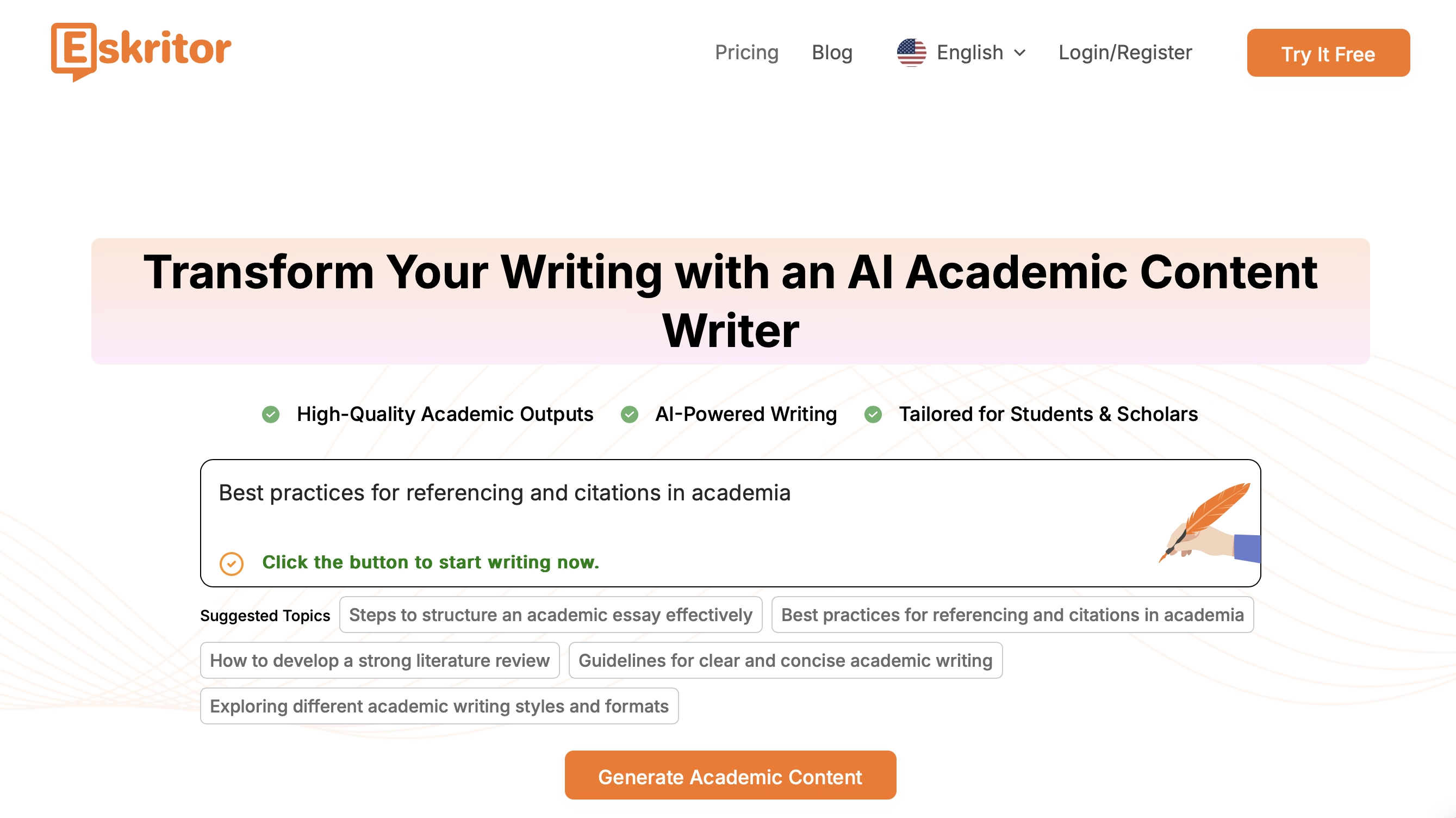
APA Citation Guide: Definition, Examples, and Format
Generate the Best Content with AI in Seconds
Generate the Best Content with AI in Seconds
APA citation establishes the framework that enables researchers, students, and scholars to credit sources in academic writing properly. The Publication Manual of the American Psychological Association provides comprehensive guidelines for formatting references, in-text citations, and the overall structure of a document. Academic writing requires attention to citation details, as proper APA citation format ensures academic integrity while demonstrating scholarly credibility in research papers, journal articles, and dissertations.
What is APA Citation?
APA citation refers to the standardized referencing system developed by the American Psychological Association. The APA citation format provides a consistent method for crediting sources in scholarly communication. APA style citation helps prevent plagiarism by properly attributing ideas, theories, data, and direct quotes to their original authors. Academic institutions require APA citation adherence as standard practice for maintaining scholarly integrity across disciplines. Why is APA Citation Important for Academic Writing?
The importance of proper APA citation extends beyond simple attribution. APA citation format creates a standardized system that allows readers to locate original sources efficiently. The structured approach of APA style guides readers through complex academic arguments while establishing credibility through proper source documentation. Academic journals, universities, and research institutions recognize APA citation as a mark of scholarly rigor and professional competence in academic writing.
What Are the Key Differences Between APA 6th and 7th Editions?
APA citation guidelines underwent significant updates when transitioning from the 6th to the 7th edition in October 2019. The APA 7th edition citation format introduced several essential changes while maintaining the core principles of the citation system. Understanding these differences ensures compliance with current academic standards when creating APA style citations.
The most notable differences in the APA 7th edition citation format include:
- Author guidelines : APA citation now permits inclusion of up to 20 authors in a reference before using an ellipsis, expanding from the previous limit of 7 authors
- DOI format : Changed from "doi:10.xxxx" to "https://doi.org/10.xxxx" for improved digital accessibility
- Publisher location : No longer required in book references within the APA bibliography format
- Heading levels : Updated formatting for the five levels of headings for improved document structure
- Singular "they" : Endorsed as a gender-neutral pronoun in formal academic writing
- Font options : Increased flexibility with fonts (e.g., Calibri 11, Arial 11, Lucida Sans 10) beyond the traditional Times New Roman
These modifications reflect the APA's commitment to making citations more inclusive, accessible, and adapted to modern research practices, particularly for digital content citation.
How to Format Papers According to APA Guidelines?

APA paper formatting follows specific rules that create a consistent appearance across academic documents. The general formatting guidelines establish a professional presentation that facilitates comprehension and review by academic audiences. The standardized APA format assists readers in navigating complex information while maintaining focus on content rather than stylistic variations.
The basic structure of papers using APA citation format typically includes these sections in sequential order:
- Title page: Contains paper title, author name(s), institutional affiliation, course information
- Abstract: Provides a brief summary of the paper (150-250 words)
- Main body: Presents the content with appropriate headings and subheadings
- References: Lists all sources cited in the text (sometimes called APA bibliography format)
- Tables and figures: Positioned after references or embedded within the text as appropriate
What Are the APA Paper Formatting Essentials?
The visual presentation of your document plays a crucial role in APA style. Proper APA paper formatting not only helps readers navigate your work but also demonstrates your attention to detail and adherence to academic conventions.
Page Layout and Structure
APA papers follow a specific layout structure with a defined order of pages. The page header contains the running head (if required) and page number. Main sections like Abstract and References are centered, bold, and begin on new pages.
Title Page Formatting
Under the 7th edition, the title page format includes:
- Paper title : Bold, centered, positioned in the upper half of the page
- Author name(s) : Centered below the title
- Institutional affiliation : The school or organization where the work was completed
- Course information : For student papers (course number, name, instructor, due date)
- Page number : In the top-right header
Font, Margins, and Spacing Requirements
The APA 7th edition citation format includes:
- Paper size : Standard 8.5 x 11 inches (Letter size) for all academic documents
- Margins : 1-inch margins on all sides of the document
- Line spacing : Double-spacing throughout the entire text for improved readability
- Alignment : Left-aligned text with a ragged right edge (not justified) to maintain consistent spacing
- Indentation : The first line of each paragraph is indented 0.5 inches
- Font selection : Times New Roman (12pt), Calibri (11pt), Arial (11pt), or Georgia (11pt)
Running Head and Page Numbers
- Professional papers : Include a running head (abbreviated title) and page number
- Student papers : In the 7th edition, student papers only need page numbers
- Format : Page numbers appear in the top-right corner
What Is an In-text Citation APA?
In-text citation APA directs readers to your reference list and gives credit to the original authors. They appear within the body of your paper. Briefly identify the source of information.
Basic In-text Citation Format
- Parenthetical citation : (Author, Year)
- Example: Research confirms this finding (Smith, 2020).
- Narrative citation : Author (Year)
- Example: Smith (2020) confirmed this finding.
- Direct quote : Include page number
- Example: "This finding was unexpected" (Smith, 2020, p. 45).
- Example: Research confirms this finding (Smith, 2020).
- Example: Smith (2020) confirmed this finding.
- Example: "This finding was unexpected" (Smith, 2020, p. 45).
Multiple Authors Citation

In-text citation APA formats vary based on the number of authors:
- Two authors : Include both names
- Example: (Johnson & Smith, 2020) or Johnson and Smith (2020)
- Three or more authors : Use the first author's name followed by "et al."
- Example: (Williams et al., 2019)
- Group authors : Use the full name the first time, then the abbreviation if applicable
- First citation: (National Institute of Mental Health [NIMH], 2020)
- Subsequent citations: (NIMH, 2020)
- Example: (Johnson & Smith, 2020) or Johnson and Smith (2020)
- Example: (Williams et al., 2019)
- First citation: (National Institute of Mental Health [NIMH], 2020)
- Subsequent citations: (NIMH, 2020)
Indirect and Direct Quotations
When incorporating source material, it’s important to consider when to paraphrase information, or whether to directly quote.
- Paraphrasing : Restate ideas in your own words with an author-date citation
- Short direct quotes (fewer than 40 words): Include in quotation marks within the text
- Block quotes (40 words or more): Start on a new line, indent 0.5 inches, no quotation marks
Citing Multiple Sources
When referencing multiple works:
- Multiple sources supporting the same idea : List alphabetically, separated by semicolons
- Example: (Chen, 2019; Roberts, 2020; Zhang, 2018)
- Same author, multiple works : Order chronologically, separate years with commas
- Example: Wilson (2018, 2020)
- Same author, same year : Add lowercase letters after the year
- Example: (Brown, 2021a, 2021b)
- Example: (Chen, 2019; Roberts, 2020; Zhang, 2018)
- Example: Wilson (2018, 2020)
- Example: (Brown, 2021a, 2021b)
How to Format the APA Reference Page?
The APA reference page format provides full bibliographic information for all sources cited in your text. This section appears at the end of your paper on a new page with the centered heading "References."
Setting Up the References Page
The APA reference page format follows these formatting guidelines:
- Heading : Center the word "References" at the top of the page
- Line spacing : Double-space all entries
- Hanging indent : First line of each entry aligned left, subsequent lines indented
- Order : Alphabetical by author's last name
- DOI or URL : Include when available, formatted as hyperlinks
Organizing References Alphabetically
As per the updated APA style, bibliography format follows specific ordering principles:
- Alphabetical order : By author's last name or the first word of the group author
- Same author : Chronological order from earliest to most recent
- Same author, same year : Alphabetical by title (adding a, b, c after the year)
- No author : Alphabetize by the first significant word in the title
Formatting Different Types of Sources
Each source type has specific formatting requirements that include author, year, title, and source information. The exact elements depend on the type of source being cited, which can be simplified with an APA citation generator.
APA Format Examples for Different Sources
Different materials require different citation elements. Here are APA format examples for common source types:
How to Create an APA Citation for Websites?
- Basic format : Author, A. A. (Year, Month Day). Title of page. Site Name. URL
- Website with author and date : Johnson, M. (2021, April 15). The impact of climate change on urban development. Climate Research Center. https://www.climateresearch.org/urban-impact
- Website with organization as author : American Psychological Association. (2020). APA style blog. https://apastyle.apa.org/blog
- Website with no date : Smith, J. (n.d.). Guide to mindfulness meditation. Mindful Living. https://www.mindfulliving.org/meditation-guide
The APA citation for website format always includes the URL but doesn't require a retrieval date unless the content is likely to change.
How to Format Book Citations in APA Style?
- Basic format : Author, A. A. (Year). Title of book. Publisher.
- Print book with one author : Garcia, R. (2019). Advances in cognitive psychology. Academic Press.
- E-book : Thompson, K. L. (2020). Digital humanities and text analysis. Oxford University Press. https://doi.org/10.xxxx
What Is the Correct Format for Citing Journal Articles in APA?
- Basic format : Author, A. A., & Author, B. B. (Year). Title of article. Title of Journal, Volume(Issue), page range. DOI or URL
- Journal article with DOI : Zhang, M., & Wilson, K. (2021). Effects of meditation on stress reduction. Journal of Mental Health, 15(2), 123-145. https://doi.org/10.xxxx/jmh.2021
- Journal article without DOI, with URL : Peterson, J., & Simmons, D. (2020). Teaching critical thinking in undergraduate education. Educational Research Quarterly, 43(1), 45-67. https://erq.org/issues/43/1/peterson
How to Cite Media Sources in APA Format?
- YouTube video : TEDx Talks. (2021, March 10). How artificial intelligence will change education [Video]. YouTube. https://www.youtube.com/watch?x=xxxxx
- Film : Nolan, C. (Director). (2020). Tenet [Film]. Warner Bros. Pictures.
- Podcast episode : Harris, S. (Host). (2021, February 15). The nature of consciousness (No. 134) [Audio podcast episode]. In Making Sense. Waking Up. https://www.makingsense.com/episodes/134
What Are the Best Practices for APA Style Citation?

Mastering the APA style guide goes beyond knowing the basic rules. These best practices and strategies will help you produce polished, professional academic work.
Time-Saving Techniques
Streamline your APA formatting process with these approaches:
- Create a personal APA template with preset margins, fonts, and headers
- Maintain a database of frequently used sources
- Group citation-related tasks for efficiency
- Use an APA citation generator like the one provided by Eskritor
- Master keyboard shortcuts for formatting elements
Ensuring Consistency Across Your Document
Consistency is key to professional APA formatting:
- Create a personal reference document for your paper
- Use search functions to check for consistent formatting throughout
- Develop a personal APA verification checklist
- Perform specific review passes for different elements (citations, references, headings)
Using Eskritor to Enhance Your APA-Formatted Papers

Eskritor offers specialized tools to support and elevate your academic writing, particularly when working with APA formatting. Whether you're writing a psychology paper, a research article, or a social sciences assignment, choosing the best AI essay writer can ensure your work aligns with the rigorous standards of APA 7th edition.
- Providing pre-formatted prompts for APA 7th edition requirements
- Checking for formatting inconsistencies and citation elements
- Helping you develop content within the APA framework
- Allowing you to share your work while maintaining style integrity
By simplifying the technical aspects of APA style, Eskritor allows you to focus more on your ideas and analysis, ultimately enhancing the quality and professionalism of your academic papers.
Conclusion
Mastering APA style citation is an essential skill for academic and professional success. The standardized format ensures clarity, consistency, and proper attribution in scholarly communication. Throughout this guide, we've explored the fundamental elements of the APA style guide, from basic formatting requirements to specific citation examples for various sources. By understanding these guidelines, you can communicate your ideas effectively while maintaining academic integrity. Additionally, using a [rewording tool](https://eskritor.com/use-rewording-tool/) can further enhance your writing clarity.
Eskritor transforms what could be a tedious process into a streamlined experience, with its AI-powered tools for document formatting, APA citation generator, and content enhancement. Try Eskritor today to experience how simple APA citation can be when you have the right tools.
Frequently Asked Questions
The 7th edition allows up to 20 authors in references (vs. 7 previously), uses "https://doi.org/" format for DOIs, eliminates publisher location in book references, provides more font options, and supports the singular "they." These changes make citations more accessible and inclusive while simplifying the format.
APA in-text citations use the author-date system. Include the author's last name and publication year in parentheses (Smith, 2020) or as part of your sentence: "Smith (2020) argues..." For direct quotes, add page numbers: (Smith, 2020, p. 45). With three or more authors, use the first author's name followed by "et al."
The best tool to generate APA citations automatically is Eskritor. It formats in-text citations and reference lists according to the latest APA 7th edition guidelines, supports multiple source types, and simplifies the writing process for students, researchers, and content creators.
An APA reference page should have "References" centered at the top, with double-spaced entries arranged alphabetically by author's last name. Use hanging indents for each entry (first line flush left, subsequent lines indented 0.5 inches). Include DOIs or URLs as hyperlinks where available, and follow specific formatting rules for each source type.
To cite social media posts, include the author's real name (if known) or screen name, the year, month and day, the first 20 words of the post as the title, the social media platform, and the URL: "Gates, B. [@BillGates]. (2021, March 15). Climate change remains one of our greatest challenges [Tweet]. Twitter. https://twitter.com/BillGates/status/..."





 location
location